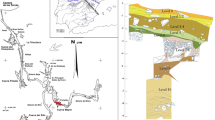Abstract
Archaeobotanical analysis has been used to reconstruct the nest and diet of a small rodent from the Classical period (first century b.c. to second century a.d.) and most probably from Greece. The nest was found in the hollow interior of a very valuable bronze statue of a young athlete, recovered from the waters of the Northern Adriatic and named the Croatian Apoxyomenos. Apoxyomenos was probably the cargo of a Roman ship on one of highly frequented sea routes in ancient times, along which, among other things, a highly developed trade in artworks was maintained. All plant remains were non-carbonised and mineralised; encrusted with metallic salts, especially of copper, and preserved in excellent condition. The nest itself (wisps of “straw” found in the hollow interior of the left forearm of the statue) was mainly composed of stems and leaves of grasses (Poaceae), but also of laurel (Laurus nobilis) leaves and other plant remains. Along with “straw”, a further 837 individual plant remains were found and analysed and 41 different plant taxa were identified. Plant remains that presumably were part of the rodent’s diet belong to various wild and cultivated plants which indicate various anthropogenic habitats probably situated somewhere on the edge of human settlement. From zoological analysis of bite marks found on fruit stones of cherry and olive, and of the potential rodent fauna in the area the statue was assumed to be in prior to becoming submerged, it was established that the rodent was most probably one of the taxa of the Mus domesticus group.






Similar content being viewed by others
References
Auffray JC, Britton-Davidian J (1992) When did the house mouse colonize Europe? Biol J Linn Soc 45:187–190
Bang P, Dahlstrom P (2001) Animal tracks and sings. Oxford University Press, New York, p 264
Beijerinck W (1947) Zadenatlas der nederlandsche flora. Ten behoeve van de botanie, palaeontologie, bodemcultuur en warenkennis. Backhuys & Meesters, Amsterdam
Horvat I, Glavač V, Ellenberg H (1974) Vegetation Südosteuropas. Gustav Fischer Verlag, Stuttgart
Jacomet S (1987) Prähistorische Getreidefunde. Eine Anleitung zur Bestimmung prähistorischer Gersten- und Weizen-Funde, 1st edn, 2nd edn 2006, http://www.pages.unibas.ch/arch/archbot/pdf/index.html. Botanisches Institut der Universität Basel, Basel
Karniš I (2004) Statue of an athlete from under the sea, island of Losinj, Croatia—conservation and restoration works. The Acta of the 16th International Congress of Antique Bronzes, Bucharest, 26–31 May 2003, Editura Cetatea de Scaun, Bucharest, pp 243–248
Körber-Grohne U (1987) Nutzpflanzen in Deutschland, Kulturgeschichte und Biologie. Theiss, Stuttgart
Küster H (1997) Kleine Kulturgeschichte der Gewürze. Beck, München
Michaux J, Cheylan G, Croset H (1990) Of mice and men. In: Castri F di, Hansen AJ, Debussche M (eds) Biological invasions in Europe and the Mediterranean Basin. Kluwer, Dordrecht, pp 263–284
Mitchell-Jones AJ, Amori G, Bogdanowicz W, Kryštufek B, Reijnders PJH, Spitzenberger F, Stubbe M, Thissen JBM, Vohralik V, Zima J (1999) The Atlas of European Mammals. Poyser natural history, London, Niethammer J (1978) Apodemus mystacinus—Felsenmaus, A. flavicollis—Gelbhalsmaus, A. sylvaticus—Waldmaus. In: Niethammer J, Krapp F (eds) Handbuch der Säugetiere Europas, Bd. 1. Akademische Verlagsgesellschaft, Wiesbaden, pp 306–358
Novak RM (1999) Walker’s mammals of the world, vol II (6th edn). The Johns Hopkins University Press, Baltimore
Petrov B (1992) Mammals of Yugoslavia: insectivores and rodents. Nat Hist Mus Belgrade 37:1–186
Reichstein H (1978) Mus musculus Linnaeus, 1758—Hausmaus. In: Niethammer J, Krapp F (eds) Handbuch der Säugetiere Europas, Band I. Akad Verlagsges, Wiesbaden, pp 421–451
Speier M, Dieckmann U, Pott R (1998) Paläobotanische Untersuchungen zu den Pflanzenfunden aus den archäologischen Ausgrabungen zur “Varus-Schlacht” bei Kalkriese (Wiehengebirge). Ber Reinh Tüxen-Ges 10:73–94
Zohary D, Hopf M (1988) Domestication of plants in the old world. 1st edn. Oxford University Press, Oxford
Acknowledgments
Part of the palaeoethnobotanical analysis was done in cooperation with the Institute for Geobotany, University of Hanover, Germany. We would like to thank our German colleagues, in particular Prof. Hansjörg Küster for helping us with the samples, for giving us full access to his carpological collection and for his advice. We would also like to express our thanks to the Croatian Conservation Institute, Zagreb, for their financial support, to Iskra Karniš, Croatian Conservation Institute, for organisation of the sampling programme and providing necessary archaeological data and to Marijana Fabečić, Croatian Conservation Institute, for making the photographs of plant remains. We also would like to thank Dr. Thomas Raus, Botanical Museum of Berlin-Dahlem, Germany, for his suggestions and for allowing us to use as yet unpublished data on the Greek flora.
Author information
Authors and Affiliations
Corresponding author
Additional information
Communicated by C.C. Bakels.
Rights and permissions
About this article
Cite this article
Šoštarić, R., Kovačić, D., Ćaleta, M. et al. The Croatian Apoxyomenos as a luxurious rodent nest: archaeobotanical and zoological analyses of organic material found inside the classical bronze statue. Veget Hist Archaeobot 17, 289–295 (2008). https://doi.org/10.1007/s00334-007-0097-7
Received:
Accepted:
Published:
Issue Date:
DOI: https://doi.org/10.1007/s00334-007-0097-7




